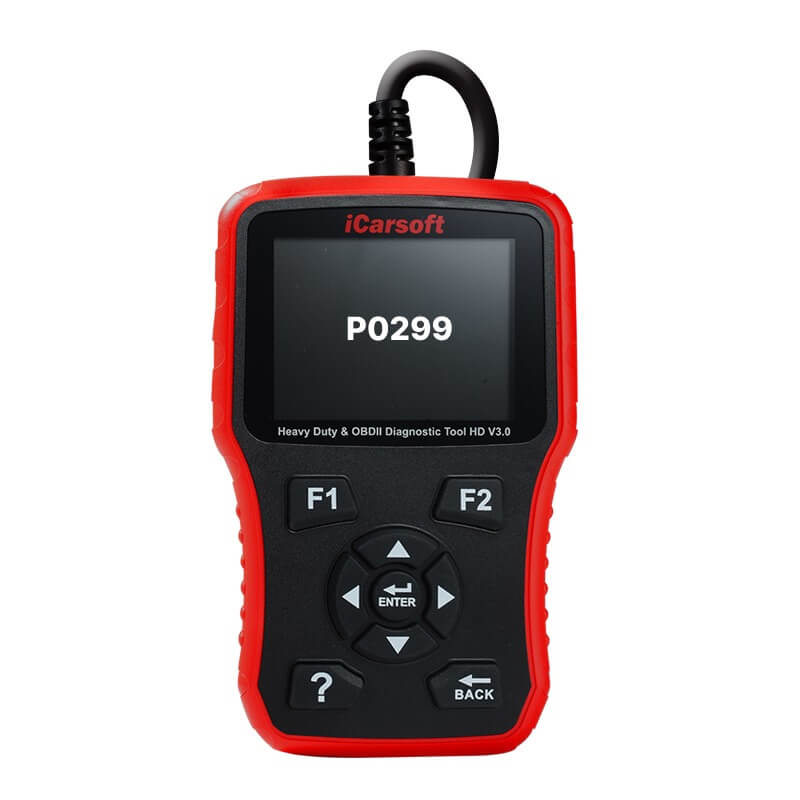P0299 – Engine Underboost
POSTED IN pcodes
The P0299 error code indicates an underboost condition in your engine, specifically related to the turbocharger or supercharger. This can result in low boost pressure, leading to engine power loss and other symptoms. Troubleshooting and diagnosing P0299 requires the expertise of a qualified mechanic, who will use diagnostic tools to check for codes, perform visual inspections, and test various components of the turbocharger or supercharger system. It is important to accurately diagnose the issue to avoid unnecessary part replacements.
Key Takeaways:
- The P0299 error code indicates an underboost condition in the engine’s turbocharger or supercharger system.
- Low boost pressure can lead to engine power loss and other symptoms.
- Diagnosing P0299 requires the expertise of a qualified mechanic using diagnostic tools and performing visual inspections.
- Accurate diagnosis is crucial to avoid unnecessary part replacements.
- Consult with a professional to address the underlying cause of P0299 and prevent further complications.
- Regular maintenance and visual inspections can help prevent underboost issues.
Symptoms of P0299
When the P0299 code is triggered, it is important to be aware of the common symptoms associated with this engine underboost error. By recognizing these symptoms, you can take prompt action to prevent further damage to your engine.
1. Engine Power Loss
One of the primary symptoms of P0299 is engine power loss. You may experience a significant decrease in horsepower and overall performance. This can be particularly noticeable during acceleration or when climbing hills.
2. Lack of Acceleration
Along with engine power loss, a general lack of acceleration is another common sign of P0299. You may find that your vehicle takes longer to reach higher speeds or struggles to maintain speed, especially when attempting to pass other vehicles or merge onto highways.
3. Illuminated Check Engine Light
The P0299 code triggers the check engine light to illuminate on your dashboard. This warning light serves as an indication that there is a malfunction in your engine’s turbocharger or supercharger system, specifically related to an underboost condition.
Buy tested tuning file for Adblue / EGR / DPF / Adblue off now!
4. Unusual Sound from the Turbocharger or Supercharger
In some cases, you may notice an unusual sound coming from the turbocharger or supercharger. This can manifest as a whining, whistling, or grinding noise. Any abnormal noises should be investigated promptly to identify and address the underlying cause.
If you are experiencing any of these symptoms, it is crucial to consult with a qualified mechanic or dealership to diagnose and resolve the P0299 code. Ignoring these symptoms may lead to further engine damage and potentially costly repairs in the future.
Causes of P0299
When it comes to the P0299 engine underboost code, there are several potential causes that can trigger this issue. It’s important to identify and address these causes in order to effectively resolve the underboost condition and prevent further complications.
Turbocharger or Supercharger Defects
One of the main culprits behind the P0299 code is a defect in the turbocharger or supercharger system. These components are responsible for boosting the engine’s air intake, and any malfunction or damage can lead to a decrease in boost pressure, resulting in the underboost condition.
Low Engine Oil Pressure
Inadequate engine oil pressure can also contribute to P0299. Proper lubrication of the turbocharger or supercharger is crucial for its smooth operation. When oil pressure is low, it can cause insufficient lubrication, leading to decreased performance and potential damage to these vital components.
EGR Defects
The Exhaust Gas Recirculation (EGR) system plays a critical role in reducing emissions. If the EGR system malfunctions or becomes clogged, it can disrupt the airflow and cause an underboost condition, triggering the P0299 code.
Air Intake Leaks or Restrictions
Any leaks or restrictions in the air intake system can affect the proper functioning of the turbocharger or supercharger. These issues can disrupt the air-to-fuel ratio, resulting in insufficient boost pressure and triggering the P0299 error code.
Faulty Boost Pressure Sensor
The boost pressure sensor is responsible for monitoring the pressure levels within the intake system. A faulty sensor can provide inaccurate readings, leading to improper boost pressure regulation and subsequently triggering the P0299 code.
“Identifying and addressing the specific cause of the P0299 code is essential for efficient troubleshooting and effective repairs.”
| Possible Causes of P0299 | Description |
|---|---|
| Turbocharger or Supercharger Defects | Issues with the turbocharger or supercharger system, such as damage or malfunction. |
| Low Engine Oil Pressure | Inadequate lubrication due to low engine oil pressure. |
| EGR Defects | Malfunction or clogging of the Exhaust Gas Recirculation (EGR) system. |
| Air Intake Leaks or Restrictions | Leakages or obstructions in the air intake system. |
| Faulty Boost Pressure Sensor | Dysfunctional or inaccurate boost pressure sensor. |
Diagnosing P0299
When faced with the P0299 – Engine Underboost code, it is crucial to conduct a thorough diagnostic process to accurately identify the underlying issue. Diagnosing P0299 requires the use of an OBD-II scanner to retrieve the code and freeze-frame data. Once obtained, a qualified mechanic will perform a visual inspection of the turbocharger or supercharger system, as well as the intake system and associated components.
In addition to the visual inspection, boost pressure readings will be checked using specialized tools, providing valuable insights into the performance of the engine’s boost system. A comprehensive inspection of the mechanical systems will also be conducted, ensuring all components are functioning optimally.
Following a step-by-step diagnostic approach allows for the accurate identification of the cause of the underboost condition, enabling targeted repairs. Let’s take a closer look at the diagnostic process for addressing P0299:
- Connect an OBD-II scanner to retrieve the P0299 code and freeze-frame data.
- Perform a visual inspection of the turbocharger or supercharger system, checking for any visible defects or damage.
- Inspect the intake system for leaks or restrictions that could contribute to the underboost condition.
- Check the boost pressure readings using specialized tools and compare them to the manufacturer’s specifications.
- Conduct a thorough inspection of the mechanical systems, including the wastegate, intercooler, and associated components.
- Record any relevant findings and compare them to potential causes of P0299.
By following this diagnostic process, mechanics can accurately pinpoint the cause of the underboost condition and proceed with targeted repairs. It is important to rely on the expertise of a qualified mechanic for an accurate diagnosis and proper repairs.
To illustrate the diagnostic process for P0299, here is a visual representation:
| Diagnostic Steps | Actions |
|---|---|
| Step 1 | Retrieve P0299 code and freeze-frame data using an OBD-II scanner. |
| Step 2 | Perform a visual inspection of the turbocharger or supercharger system. |
| Step 3 | Inspect the intake system for leaks or restrictions. |
| Step 4 | Check boost pressure readings using specialized tools. |
| Step 5 | Conduct a thorough inspection of the mechanical systems. |
| Step 6 | Record findings and compare them to potential causes of P0299. |
Fixing P0299
Once the cause of P0299 – Engine Underboost has been determined, it is crucial to proceed with the appropriate repairs to rectify the underboost condition in the engine. Below are common solutions that can effectively address the P0299 error code:
- Intake Air System Repair: Check for any loose or damaged parts in the intake air system, including hoses, clamps, and connections. Repair or replace any components that are found to be faulty.
- Air Filter Replacement: Inspect the air filter and replace it if it is dirty or clogged. A clean air filter ensures proper airflow, which is essential for optimal engine performance.
- Engine Oil Pressure Repair: Address any issues with low engine oil pressure by checking the oil level and quality. Replace or repair any faulty components (such as the oil pump) that may be causing low oil pressure.
- Boost Pressure Sensor Replacement: If the boost pressure sensor is faulty, replacing it can help resolve the underboost condition. Ensure that the new sensor is compatible with the make and model of your vehicle.
- EGR Replacement: Examine the Exhaust Gas Recirculation (EGR) system for defects or malfunctions. If necessary, replace the EGR valve or other faulty components to restore proper engine performance.
- Turbocharger or Supercharger Replacement: In some cases, the turbocharger or supercharger may need to be replaced entirely to fix the underboost condition. Consult with a qualified mechanic to determine if a replacement is necessary.
It is important to note that each repair should be thoroughly tested to ensure successful rectification of the P0299 fault code before moving on to the next repair. This will help avoid unnecessary part replacements and ensure an accurate diagnosis and effective resolution of the underboost condition.

In the next section, we will discuss prevention and maintenance strategies to help avoid the occurrence of P0299 – Engine Underboost and ensure the long-term health of your engine’s turbocharger or supercharger system.
Prevention and Maintenance
To prevent P0299 – Engine Underboost and other engine underboost issues, regular maintenance is key. By following a proactive maintenance routine, you can identify potential problems early on and take the necessary steps to prevent them from escalating.
A comprehensive preventative maintenance plan should include the following:
- Regular visual inspections: Conduct visual inspections of the turbocharger or supercharger system to check for any visible signs of damage or wear. Look out for loose connections, leaks, or cracks that could impact boost pressure.
- Oil and filter changes: Adhere to the manufacturer’s recommendations for oil and filter changes. Clean oil and a fresh filter can help maintain proper lubrication and prevent the accumulation of debris that could affect the turbocharger or supercharger.
- Wiring and connector checks: Inspect the wiring and connectors related to the turbocharger or supercharger system. Look for any signs of fraying, corrosion, or damaged connectors that may cause electrical issues and impact performance.
Following these preventive measures can significantly reduce the risk of encountering P0299 – Engine Underboost and ensure the optimal performance of your vehicle’s turbocharger or supercharger system.
Benefits of Regular Maintenance
Engaging in regular maintenance practices helps keep your engine in top shape and offers several benefits:
“Regular visual inspections, oil changes, and checks on wiring and connectors can prevent the onset of P0299 – Engine Underboost and preserve the performance and longevity of your turbocharger or supercharger system. By investing time and effort into maintenance, you can avoid costly repairs, improve fuel efficiency, and experience smoother acceleration.”
Don’t compromise on maintenance; it’s an investment in the longevity of your engine.
| Maintenance Task | Frequency | Description |
|---|---|---|
| Visual Inspections | Every 3 months | Inspect the turbocharger or supercharger system for any visible damage, leaks, loose connections, or cracks. |
| Oil and Filter Changes | Every 5,000 to 7,500 miles | Adhere to the manufacturer’s recommended oil change interval and replace the filter to ensure proper lubrication and prevent debris buildup. |
| Wiring and Connector Checks | Every 6 months | Inspect the wiring and connectors related to the turbocharger or supercharger system for fraying, corrosion, or damage. |
Regular maintenance and inspections are your first line of defense against P0299 – Engine Underboost. By taking proactive steps, you can enjoy a smoother driving experience and avoid costly repairs down the road.
Professional Assistance
If you find yourself in a situation where professional assistance is unavailable or if you’re seeking an alternative solution, there are companies that offer the option of permanently removing the P0299 code. This involves uploading your Engine Control Unit (ECU) file to a secure portal where the code can be permanently eliminated. However, it’s important to note that while this may remove the code, it does not address the underlying issue causing the engine underboost condition. Therefore, it is still highly recommended to consult with a qualified mechanic for an accurate diagnosis and proper repairs.
Seeking professional assistance ensures that the root cause of P0299 is properly identified and resolved. A qualified mechanic will have the expertise and diagnostic tools necessary to accurately diagnose the issue and prevent further complications. Attempting to address the problem without professional guidance may lead to ineffective repairs and potential damage to other engine components.
While the option of permanently removing the P0299 code through ECU file upload may seem tempting, it’s essential to prioritize the long-term health and performance of your vehicle. Consult with a trusted mechanic who can provide the necessary expertise to resolve the underboost condition effectively.
Remember, your vehicle’s performance and safety depend on a thorough and accurate diagnosis, followed by appropriate repairs. Relying on professional assistance ensures reliable results and peace of mind.

Conclusion
The P0299 code, also known as the engine underboost code, is a serious issue that indicates an underboost condition in your vehicle’s turbocharger or supercharger system. If left untreated, it can lead to engine power loss and other symptoms that can affect your driving experience.
To address the P0299 code and prevent further complications, accurate diagnosis and proper repairs are essential. It is important to consult with a qualified mechanic who can use diagnostic tools to identify the underlying cause of the underboost condition. By following the recommended diagnostic steps and performing necessary repairs, you can restore your engine’s optimal performance.
Regular maintenance and visual inspections are key to preventing underboost issues in the future. By conducting regular inspections of your turbocharger or supercharger system, performing oil and filter changes as recommended, and checking for any issues with wiring and connectors, you can reduce the risk of encountering P0299 and ensure the longevity of your engine.
If you require professional assistance or are looking for an alternative solution, some companies offer the option of permanently removing the P0299 code by uploading your Engine Control Unit (ECU) file to a portal. However, it is important to note that this may not address the underlying issue causing the underboost condition and consulting with a qualified mechanic is still recommended for accurate diagnosis and proper repairs.
FAQ
What does the P0299 error code indicate?
The P0299 error code indicates an underboost condition in the engine, specifically related to the turbocharger or supercharger.
What are the symptoms of P0299?
The symptoms of P0299 include engine power loss, a general lack of acceleration, and an illuminated check engine light. In some cases, there may also be an unusual sound coming from the turbocharger or supercharger.
What are the common causes of P0299?
The common causes of P0299 include defects in the turbocharger or supercharger, low engine oil pressure, EGR defects, air intake leaks or restrictions, and faulty boost pressure sensors.
How is P0299 diagnosed?
P0299 is diagnosed using an OBD-II scanner to retrieve the code and freeze-frame data. A visual inspection of the turbocharger or supercharger system, as well as the intake system and other associated components, will be conducted. Boost pressure readings and mechanical system inspections will also be performed.
How is P0299 fixed?
P0299 can be fixed by repairing or replacing loose or damaged parts of the intake air system, replacing the air filter, addressing low engine oil pressure issues, replacing the boost pressure sensor, replacing the EGR system, or even replacing the entire turbocharger or supercharger.
How can P0299 be prevented?
P0299 can be prevented by performing regular visual inspections of the turbocharger or supercharger system, conducting oil and filter changes as recommended, and checking for any issues with wiring and connectors.
Is professional assistance available for P0299?
Yes, professional assistance is available for diagnosing and repairing P0299. It is recommended to consult with a qualified mechanic for an accurate diagnosis and proper repairs.
Can the P0299 code be permanently removed?
Some companies offer the option of permanently removing the P0299 code by uploading your Engine Control Unit (ECU) file to a portal where the code can be removed. However, it is important to note that this may not address the underlying issue causing the underboost condition, and professional assistance is still recommended.


